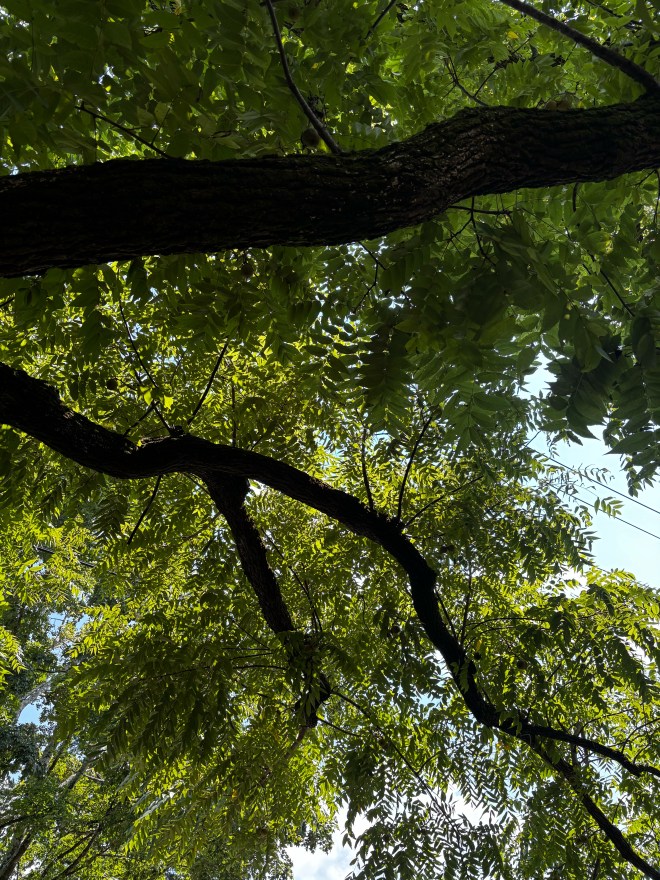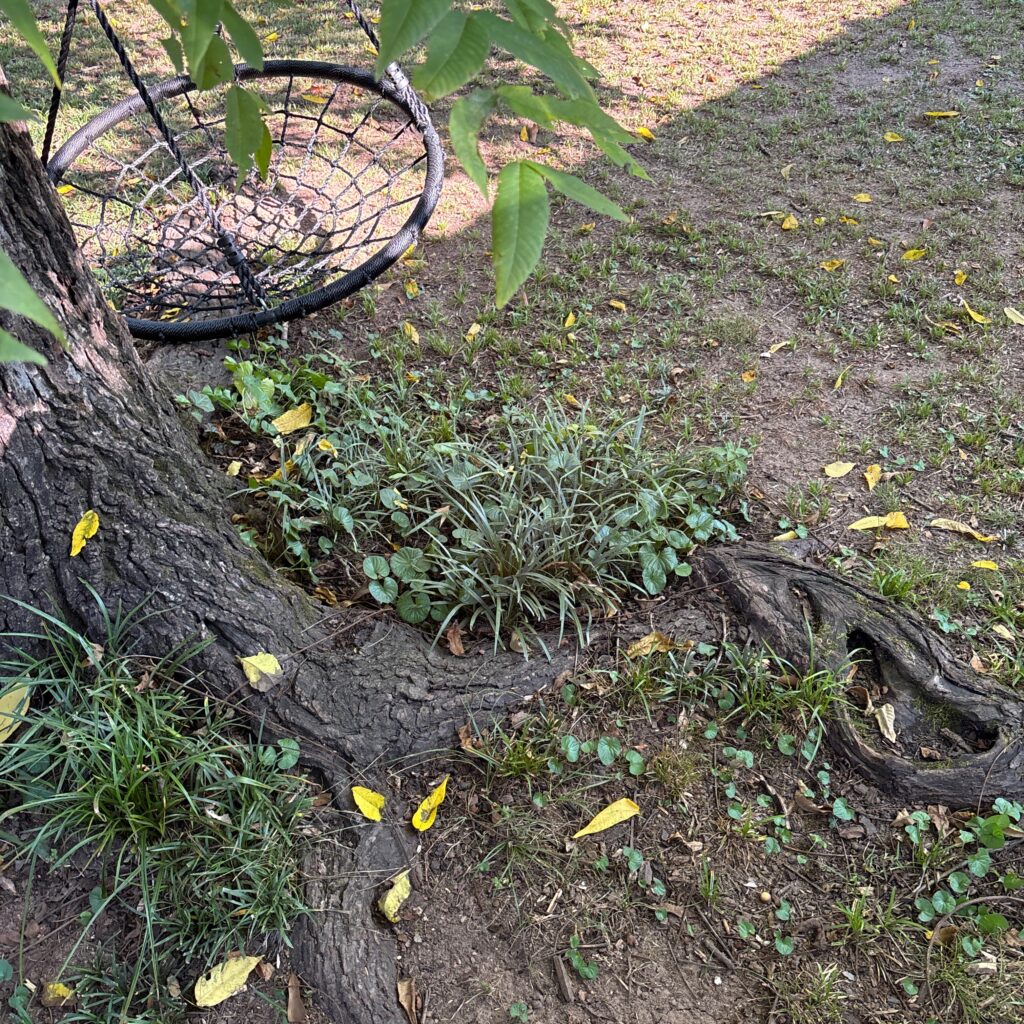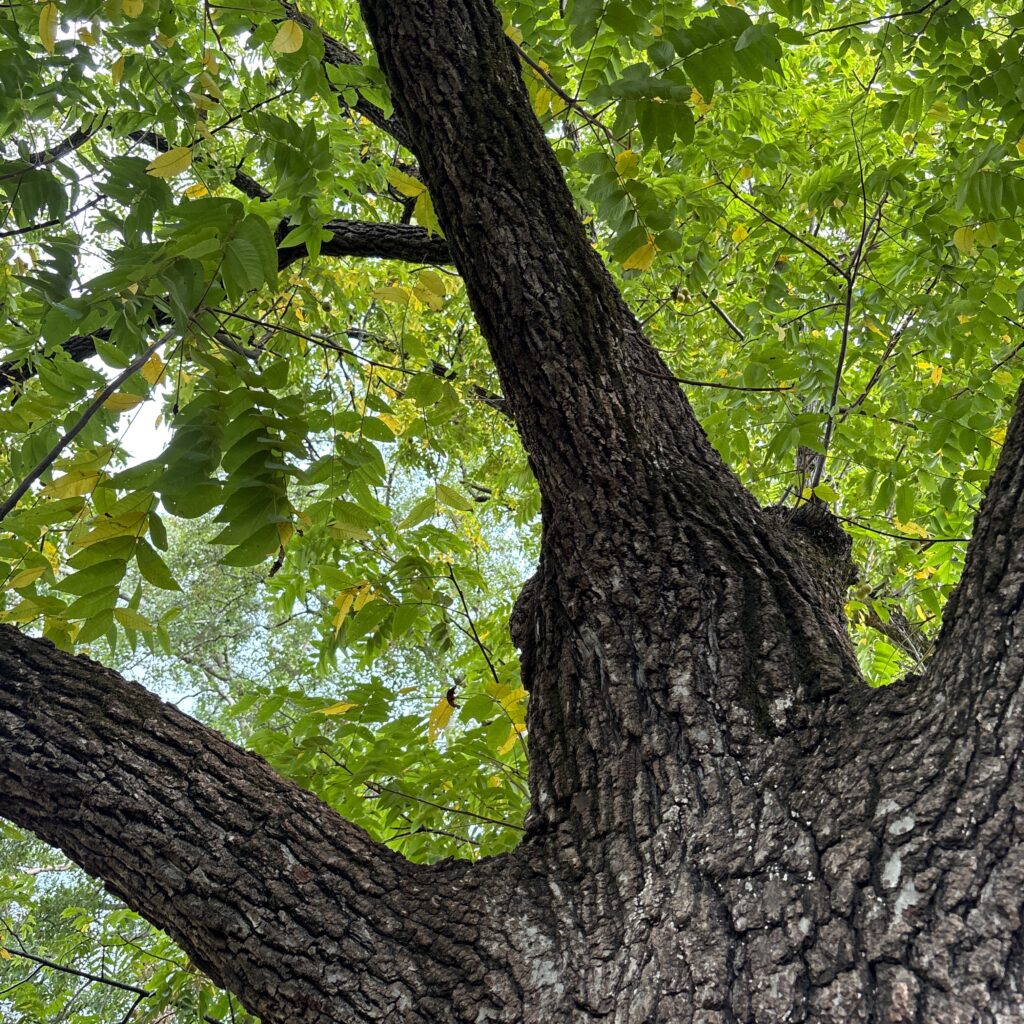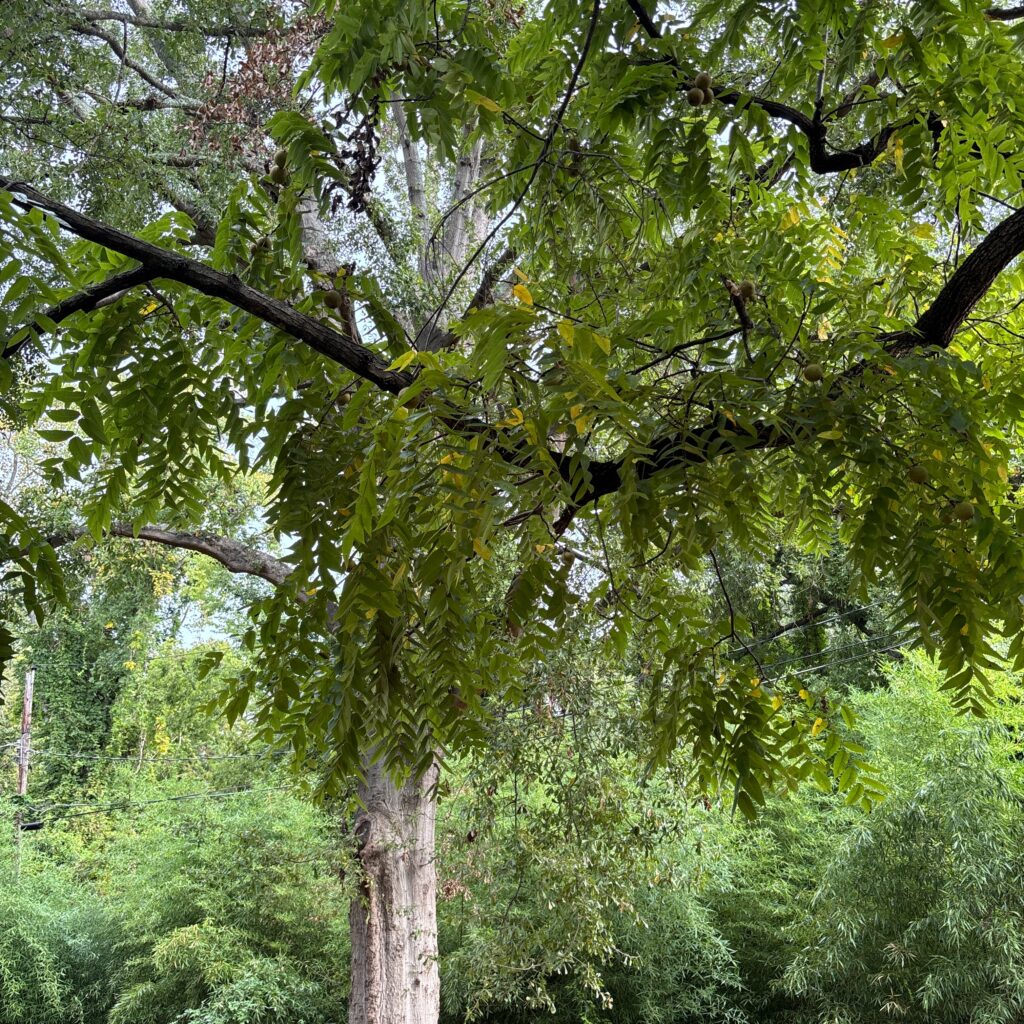Introduction and Summary
This journal is an unfolding record of attention. It is partly a field log, part spiritual practice, rooted in my PhD work at the California Institute of Integral Studies, where I explore the intersections of ecology, spirituality, and phenomenology. Inspired by process-relational thought, Indigenous ecological wisdom, and the rhythms of the more-than-human world, this page offers entries tracing my engagement with a single black walnut tree located here in Spartanburg, SC through the seasons.
Tracking, in this context, is not simply observation; it is an intentional act of presence and relational reciprocity. It is a response to what philosopher Maurice Merleau-Ponty called the “flesh of the world,” or a participatory ontology in which I too am being tracked, reconstituted by my encounters with wind, bark, squirrel, and shadow. This practice emerges from a desire to live in kinship with the land, as part of an ongoing inquiry into what Thomas Berry named our “Great Work”: to realign human consciousness with the deeper patterns of life.
I use the app Day One for these journal entries as well as Apple’s iPhone and AirPods Pro 2 for the microphone.
Audio MP3 files accompany each photographic entry and are playable on mobile and web browsers or for download. Length varies from approximately 5 mins to 15 mins. All photographs were taken using Apple’s iPhone.
AI-generated summary of all the audio entries below via Google’s Notebook LM (15 minutes):
Black Walnut Information
Black walnut (Juglans nigra) is an essential component of Southeastern forests and provides an ecological as well as economic benefit to South Carolina. The dark wood is popular in crafting furniture, and the walnuts make tasty treats.
The native range of black walnuts does not extend into the Lowcountry, but they are planted in residential landscapes throughout the state, especially in older neighborhoods. Characterized by their dark, deeply furrowed bark, black walnuts have large compound leaves with 15-23 leaflets. They have numerous male catkins and terminal female flowers that ripen into round, semifleshy fruit that contain the sought-after nut.
via Clemson University Extension Office (PDF) and NC State University Extension Office.
Monday, January 27, 2025


49 degrees and Cloudy / Wet – Waning Crescent
I’m beginning my tracking journal here. It’s a cold and rainy morning and the Black Walnut is reflecting my mood about this weather!
Wednesday, January 29, 2025



46 Degrees and Cloudy – New Moon
Thursday, January 30, 2025

Friday, January 31, 2025


Tuesday, February 4, 2025

55 Degrees and Sunny
Wednesday, February 5, 2025

59 Degrees and Mostly Clear
Thursday, February 6, 2025
64 Degrees and Mostly Clear
Friday, February 7, 2025



57 Degrees and Sunny
Monday, February 10, 2025
48 Degrees and Cloudy
Thursday, February 20, 2025



41 Degrees Cold and Snowy!
Saturday, February 22, 2025

44 Degrees and Clear
Friday February 28, 2025

58 Degrees and Clear
Saturday, March 1, 2025

58 Degrees and Cloudy
Thursday, March 6, 2025

45 Degrees and Windy
Saturday, March 8, 2025

63 Degrees and Clear
Sunday, March 23, 2025

49 Degrees and Clear
Sunday, March 30, 2025

76 Degrees and Partly Cloudy
Monday, April 14, 2025

80 Degrees and Clear (and Beautiful)
Wednesday, April 16, 2025

62 Degrees and Clear
Tuesday, April 22, 2025

74 Degrees and Mostly Cloudy
Wednesday, April 23, 2025: Seedpods!

64 Degrees and Cloudy
Thursday, April 24, 2025: Rain

64 Degrees with Heavy Rain
Friday, April 25, 2025: Imagination?

65 Degrees and Cloudy
Monday, April 28, 2025: The Cross ✝️

65 Degrees and Clear
Tuesday, April 29, 2025

64 Degrees and Mostly Sunny
Friday, September 5, 2025


83 Degrees and Partly Cloudy 🌤️
Wednesday, September 10, 2025: Merleau-Ponty and Seeds



64 Degrees and Sunny 🌞
Friday, September 12, 2025: Human and Invasiveness


59 Degrees and Clear ☀️
Wednesday, September 17, 2025: On the (Tree) Soul



68 Degrees and Partly Cloudy ⛅
Monday, September 22, 2025: Remember The Mountain Bed


74 Degrees and Mostly Cloudy🌤️
Jeff Tweedy of Wilco performing Remembering the Mountain Bed (YouTube)
Wednesday, September 24, 2025: Resting Heart (and Root) Rates




81 Degrees and Sunny 🌞
Thursday, September 25, 2025: Rain and Plant Intelligence(s)




72 Degrees and Drizzling 🌧️
Friday, September 26, 2025: Rain and Scattering Seeds

74 Degrees and Cloudy 🌧️
Wednesday, October 1, 2025



69 Degrees and Cloudy ☁️
Thursday, October 2, 2025: Tree Bark Phenomena

64 Degrees and Clear ☀️
Sunday, October 6, 2025

Emmylou has picked up on my habit (a consecrated habit, to use Merleau-Ponty’s phrasing), and I walked out into the backyard on Sunday to find her reading aloud with the Black Walnut, as I often do during the week.
The tree has begun dropping its heavy fruit, and the air smells faintly sharp as the husks split open on the ground. I noticed how she read with complete absorption, as if she and the tree were both listening together as two kinds of stillness sharing the same breath. It felt like a reminder that reading and resting under a tree are both forms of attention, both ways of being in relationship with a world that holds and teaches us quietly.
As a Dad, I was moved to a quick tear.
Sunday, October 12, 2025: Becoming Walnut



73 Degrees and Cloudy (Rain on the way from the Nor’easter this evening! 🌧️
Monday, October 13, 2025: Fall Colors



66 Degrees, Clear, and Beautiful! ☀️
Tuesday, October 14, 2025: Communication and Classification


72 Degrees and Sunny 🌞
Wednesday, October 15, 2025: Phenomenological Take



Thursday, October 16, 2025: Geographies

Friday, October, 17, 2025: Parenthood


62 Degrees and Beautiful 🌞
Wednesday, October 22, 2025: Experiencing Fall for the First Time (Here)



59 Degrees and Sunny 🌞
Thursday, October 23, 2025: Merleau Ponty and Gestures of Dirty Language



57 Degrees and Clear! ☀️
Friday, October 24, 2025: Our Fluid Atmosphere


52 Degrees and Partly Cloudy ⛅
Sunday, October 26, 2025: The Phenomenology of Falling Hawks and S’mores



60 Degrees and Cloudy ☁️
Monday, October 27, 2025: Rain and Black Walnut Bark

52 Degrees and Rainy and COLD! 🌧️
Thursday, October 30, 2025: Steam


53 Degrees and Sunny 🌞 (finally!)
Friday, October 31, 2025: Halloween and Fear of Darkness 👻



Bob Dylan – Not Dark Yet (Spotify)
Beethoven – Ode to Joy (Spotify)
44 Degrees and Sunny 🌞
Saturday, November 1, 2025: Ecology of Thought


The Ecology of Thought (my post and link to Marder’s PDF)
54 Degrees and Sunny 🌞
Tuesday, November 4, 2025: Changing Perceptions



56 Degrees and Clear ☀️
Wednesday, November 5, 2025: Echoes of Laughter


62 Degrees and Clear 🌞
Thursday, November 6, 2025: Thinking Photosynthetically



66 Degrees and Sunny 🌞
Friday, November 7, 2025: Retreating to Our Roots


55 Degrees and Cloudy (and Cool!) ☁️
Monday, November 10, 2025: Cold (No Rain and Snow, Though)



Cold Rain and Snow – Grateful Dead (Spotify)
41 Degrees and Clear
Tuesday, November 11, 2025: Last Leaf on the Tree

Last Leaf on the Tree – Willie Nelson (Spotify)
41 Degrees and Clear
Thursday, November 13, 2025: Trans-dimensional Shadows



59 Degrees and Partly Cloudy ⛅
Friday, November 14, 2025: Steel and Glass



Steel and Glass – John Lennon (Spotify)
60 Degrees and Clear 🌞
Sunday, November 16, 2025: Sunday Morning Coming Down

Sunday Morning Coming Down – Johnny Cash (Spotify)
60 Degrees and Sunny ☀️
Monday, November 17, 2025: New Trees and Old Leaves

64 Degrees and Sunny 🌞
Tuesday, November 18, 2025: Investing in the Millennium


60 Degrees and Partly Cloudy ⛅
Wednesday, November 19, 2025: Phenomenology of Me (and a Tree)

71 Degrees and Clear 🌞
Thursday, November 20, 2025: Browning of Religion


60 Degrees and Mostly Cloudy ☁️
Tracking: A Year of Attention
Here’s an updated summary of my year with the black walnut courtesy of Google’s fantastic NotebookLM. I have to admit that I got a little teary eyed listening to the audio recap as well as the video recap the first time…
Audio Overview after 11 months:
Saturday, November 22, 2025: Ben and Lily’s Thoughts on the Black Walnut


72 Degrees and Mostly Clear 🌞
Monday, November 24, 2025: My Own Ramblings


60 Degrees and Clear 🌞
Friday, November 28, 2025: Feeling Welcomed


47 Degrees and Clear 🌞
Monday, December 1, 2025: More-Than-Human Persons


41 Degrees and Cloudy and Damp ☁️ 🥶
Tuesday, December 2, 2025: New Discoveries


43 Degrees and Cloudy after Rain 🌧️
Thursday, December 4, 2025: Plasma Thoughts


44 Degrees and Cloudy and Cold! ☁️ 🥶
Monday, December 8, 2025: Hawks and Chicadees

39 Degrees and Cloudy ☁️
Tuesday, December 9, 2025: Tempests
39 Degrees and Chilly Overcast 🌤️
Friday, December 12, 2025: Intelligences


48 Degrees and Clear ☀️
Sunday, December 14, 2025: Windy Closure


39 Degrees and Incredibly Windy! 🌬️